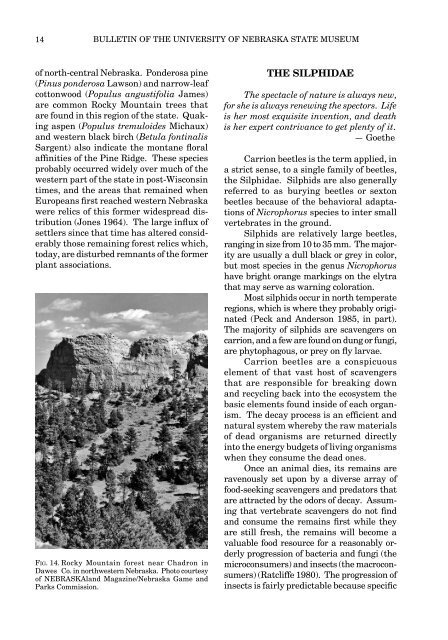Download full text - University of Nebraska State Museum
Download full text - University of Nebraska State Museum
Download full text - University of Nebraska State Museum
You also want an ePaper? Increase the reach of your titles
YUMPU automatically turns print PDFs into web optimized ePapers that Google loves.
14<br />
BULLETIN OF THE UNIVERSITY OF NEBRASKA STATE MUSEUM<br />
<strong>of</strong> north-central <strong>Nebraska</strong>. Ponderosa pine<br />
(Pinus ponderosa Lawson) and narrow-leaf<br />
cottonwood (Populus angustifolia James)<br />
are common Rocky Mountain trees that<br />
are found in this region <strong>of</strong> the state. Quaking<br />
aspen (Populus tremuloides Michaux)<br />
and western black birch (Betula fontinalis<br />
Sargent) also indicate the montane floral<br />
affinities <strong>of</strong> the Pine Ridge. These species<br />
probably occurred widely over much <strong>of</strong> the<br />
western part <strong>of</strong> the state in post-Wisconsin<br />
times, and the areas that remained when<br />
Europeans first reached western <strong>Nebraska</strong><br />
were relics <strong>of</strong> this former widespread distribution<br />
(Jones 1964). The large influx <strong>of</strong><br />
settlers since that time has altered considerably<br />
those remaining forest relics which,<br />
today, are disturbed remnants <strong>of</strong> the former<br />
plant associations.<br />
Fig. 14. Rocky Mountain forest near Chadron in<br />
Dawes Co. in northwestern <strong>Nebraska</strong>. Photo courtesy<br />
<strong>of</strong> NEBRASKAland Magazine/<strong>Nebraska</strong> Game and<br />
Parks Commission.<br />
The SIlPhIDAe<br />
The spectacle <strong>of</strong> nature is always new,<br />
for she is always renewing the spectors. Life<br />
is her most exquisite invention, and death<br />
is her expert contrivance to get plenty <strong>of</strong> it.<br />
— Goethe<br />
Carrion beetles is the term applied, in<br />
a strict sense, to a single family <strong>of</strong> beetles,<br />
the Silphidae. Silphids are also generally<br />
referred to as burying beetles or sexton<br />
beetles because <strong>of</strong> the behavioral adaptations<br />
<strong>of</strong> Nicrophorus species to inter small<br />
vertebrates in the ground.<br />
Silphids are relatively large beetles,<br />
ranging in size from 10 to 35 mm. The majority<br />
are usually a dull black or grey in color,<br />
but most species in the genus Nicrophorus<br />
have bright orange markings on the elytra<br />
that may serve as warning coloration.<br />
Most silphids occur in north temperate<br />
regions, which is where they probably originated<br />
(Peck and Anderson 1985, in part).<br />
The majority <strong>of</strong> silphids are scavengers on<br />
carrion, and a few are found on dung or fungi,<br />
are phytophagous, or prey on fly larvae.<br />
Carrion beetles are a conspicuous<br />
element <strong>of</strong> that vast host <strong>of</strong> scavengers<br />
that are responsible for breaking down<br />
and recycling back into the ecosystem the<br />
basic elements found inside <strong>of</strong> each organism.<br />
The decay process is an efficient and<br />
natural system whereby the raw materials<br />
<strong>of</strong> dead organisms are returned directly<br />
into the energy budgets <strong>of</strong> living organisms<br />
when they consume the dead ones.<br />
Once an animal dies, its remains are<br />
ravenously set upon by a diverse array <strong>of</strong><br />
food-seeking scavengers and predators that<br />
are attracted by the odors <strong>of</strong> decay. Assuming<br />
that vertebrate scavengers do not find<br />
and consume the remains first while they<br />
are still fresh, the remains will become a<br />
valuable food resource for a reasonably orderly<br />
progression <strong>of</strong> bacteria and fungi (the<br />
microconsumers) and insects (the macroconsumers)<br />
(Ratcliffe 1980). The progression <strong>of</strong><br />
insects is fairly predictable because specific
















